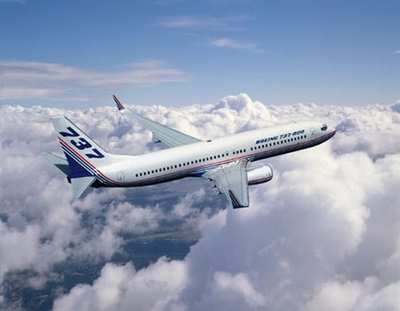Strong Demand Seen For New, More Fuel Efficient Single-Aisle
Airplanes
Even as some economists warn of a possible double-dip recession
in the short term, Boeing projects that air carriers in North
America will take delivery of about 7,200 new airplanes over the
next 20 years at an investment of $700 billion.

New airplane deliveries in Canada and the United States will be
driven largely by the need to retire older, less fuel-efficient
single-aisle airplanes and regional jets, as airlines replace them
with new-generation, more fuel-efficient models. (For the purposes
of the Boeing forecast, the North America market consists of the
U.S. and Canada. Mexico is included in Boeing's forecast for Latin
America.)
"North America is a large, mature market, and we expect
passenger traffic for the region to grow at a modest rate of 3.4
percent," said Randy Tinseth, vice president of Marketing, Boeing
Commercial Airplanes, who released Boeing's 2010 North America
market outlook Thursday in Montreal. "The fast-paced lifestyles in
Canada and the U.S. require rapid, frequent and reliable
coast-to-coast and interregional transportation. Driven by this
demand, nearly three-quarters of the new deliveries over the next
20 years will be single-aisle airplanes."
Taking retirements of airplanes into account, the North America
fleet will grow from 6,590 airplanes today to about 9,000 airplanes
by 2029.
Boeing forecasts that single-aisle airplanes will grow from 56
percent of the total North America fleet today to 71 percent of the
fleet by 2029. Airlines are increasingly focusing on airplane age
as fuel-thirsty, older airplanes weigh increasingly on earnings.
Increased attention to aviation's impact on global climate change
also will be a factor in selecting airplanes that produce lower
carbon emissions.
Newer airplane types such as the Next-Generation 737 offer
significant advantages in environmental performance as well as
improved capabilities, fuel efficiency and maintenance costs.

B737-800
"After several years of losses among the region's air carriers,
we're seeing signs of improvement and airlines are beginning to
implement fleet renewal plans as they look to the future," Tinseth
said. "To help meet this demand, Boeing Commercial Airplanes will
continue to work closely with our more than 500 suppliers and
partners in Canada. Boeing imports parts and services from Canada
amounting to more than a billion U.S. dollars a year, more than
$625 million of which is associated with Boeing Commercial
Airplanes."
Twin-aisle fleets will evolve in the region as airlines continue
to expand international point-to-point services to a wider range of
airport pairs and frequencies. Small- and mid-sized twin-aisle
airplanes will grow to represent 19 percent of the North America
fleet by 2029.
Within the North America market, Boeing sees a demand for 1,180
new, efficient twin-aisle airplanes such as the 787 Dreamliner.
Twin-aisles will account for only 16 percent of total airplane
demand in the region over 20 years but will have a proportionally
higher share of delivery cost, at 37 percent of the overall
investment.
Large airplanes (747-size and larger) will not see significant
demand in North America, with only about 40 units (all freighters),
or one percent of the total investment.

B747-8 Freighter
Boeing also forecasts declining demand for regional jets in
North America as airlines shift to more fuel-efficient turboprops
or larger jetliner models. High fuel prices, intensified
competition and the superior efficiencies of larger single-aisles
will take a toll on the economics of small regional jets. This
category will account for just 4 percent of the total investment
for new airplanes, with only 800 new regional jet deliveries over
the next 20 years, nearly all for replacement.
 ANN's Daily Aero-Linx (04.16.24)
ANN's Daily Aero-Linx (04.16.24) Aero-News: Quote of the Day (04.16.24)
Aero-News: Quote of the Day (04.16.24) Airborne 04.10.24: SnF24!, A50 Heritage Reveal, HeliCycle!, Montaer MC-01
Airborne 04.10.24: SnF24!, A50 Heritage Reveal, HeliCycle!, Montaer MC-01 Airborne 04.12.24: SnF24!, G100UL Is Here, Holy Micro, Plane Tags
Airborne 04.12.24: SnF24!, G100UL Is Here, Holy Micro, Plane Tags Airborne-Flight Training 04.17.24: Feds Need Controllers, Spirit Delay, Redbird
Airborne-Flight Training 04.17.24: Feds Need Controllers, Spirit Delay, Redbird





